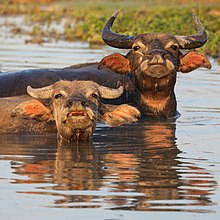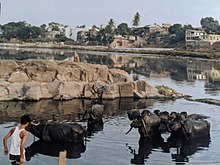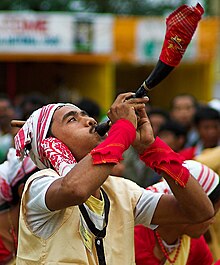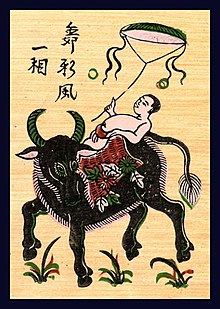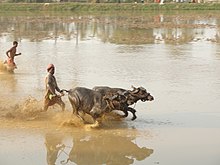
The zebu, sometimes known in the plural as indicine cattle, Camel cow or humped cattle, is a species or subspecies of domestic cattle originating in South Asia. Zebu, like many Sanga cattle breeds, differs from taurine cattle by a fatty hump on their shoulders, a large dewlap, and sometimes drooping ears. They are well adapted to withstanding high temperatures and are farmed throughout the tropics.

Bovines comprise a diverse group of 10 genera of medium to large-sized ungulates, including cattle, bison, African buffalo, water buffalos, and the four-horned and spiral-horned antelopes. The evolutionary relationship between the members of the group is still debated, and their classification into loose tribes rather than formal subgroups reflects this uncertainty. General characteristics include cloven hooves and usually at least one of the sexes of a species having true horns. The largest extant bovine is the gaur.

Bubalus is a genus of Asiatic bovines that was proposed by Charles Hamilton Smith in 1827. Bubalus and Syncerus form the subtribe Bubalina, the true buffaloes.

Carabaos are a genetically distinct population of swamp-type water buffaloes from the Philippines. They descended from domesticated swamp buffalo populations from Taiwan that were introduced to the Philippines in the Neolithic via the Austronesian expansion. They were also further introduced to Sulawesi and Borneo of eastern Indonesia and Malaysia.

The tamaraw or Mindoro dwarf buffalo is a small buffalo belonging to the family Bovidae. It is endemic to the island of Mindoro in the Philippines, and is the only endemic Philippine bovine. It is believed, however, to have once also thrived on the larger island of Luzon. The tamaraw was originally found all over Mindoro, from sea level up to the mountains, but because of human habitation, hunting, and logging, it is now restricted to only a few remote grassy plains and is now a critically endangered species.
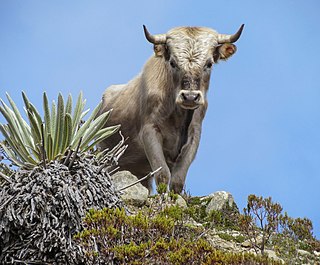
A feral animal or plant is one that lives in the wild but is descended from domesticated individuals. As with an introduced species, the introduction of feral animals or plants to non-native regions may disrupt ecosystems and has, in some cases, contributed to extinction of indigenous species. The removal of feral species is a major focus of island restoration.

A bovid hybrid is the hybrid offspring of members of two different species of the bovid family. There are 143 extant species of bovid, and the widespread domestication of several species has led to an interest in hybridisation for the purpose of encouraging traits useful to humans, and to preserve declining populations. Bovid hybrids may occur naturally through undirected interbreeding, traditional pastoral practices, or may be the result of modern interventions, sometimes bringing together species from different parts of the world.

The Murrah buffalo is a breed of water buffalo mainly kept for milk production. It originates in Haryana and Punjab of India, where it is kept in the districts of Bhiwani, Agra, Hisar, Rohtak, Jind, Jhajhar, Fatehabad, Gurgaon and the capital region of Delhi. It has been used to improve the milk production of dairy buffalo in other countries, such as Italy, Bulgaria and Egypt. A Murrah buffalo at the Lakshmi Dairy Farm in Punjab set a record of 26.335 kg (58.06 lb) of milk in the 2016 National Livestock Competition and Expo. In Brazil, this breed of buffalo is used for production of both meat and milk. Murrahs sell for a high price.
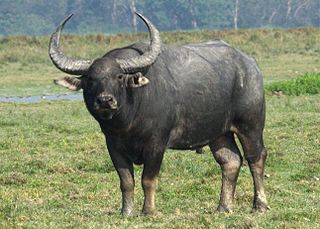
The wild water buffalo, also called Asian buffalo, Asiatic buffalo and wild buffalo, is a large bovine native to the Indian subcontinent and Southeast Asia. It has been listed as Endangered in the IUCN Red List since 1986, as the remaining population totals less than 4,000. A population decline of at least 50% over the last three generations is projected to continue. The global population has been estimated at 3,400 individuals, of which 3,100 (91%) live in India, mostly in Assam. The wild water buffalo is the most likely ancestor of the domestic water buffalo.

The Philippine Carabao Center an attached agency of the Department of Agriculture, was established at Science City of Muñoz in Nueva Ecija province in 1992 to breed and cross carabao based on high-yield Murrah buffalo in the Philippines as a multi-purpose animal that can be raised for milk, meat, hide, and draft.

The goat or domestic goat is a species of domesticated goat-antelope that is mostly kept as livestock. It was domesticated from the wild goat of Southwest Asia and Eastern Europe. The goat is a member of the family Bovidae, meaning it is closely related to the sheep. There are over 300 distinct breeds of goat. It is one of the oldest domesticated species of animal, according to archaeological evidence that its earliest domestication occurred in Iran at 10,000 calibrated calendar years ago.
In Sri Lanka many farmers depend on animal husbandry for their livelihood, but not a large proportion. Therefore, many livestock products have to be imported. The main livestock products in Sri Lanka are milk, meat and eggs. Hides, wools and other products are still not produced within the country. Animal power formerly used in the cultivation of rice and vegetables have been replaced by modern technology to farmlands. However animal husbandry plays an important role in the rural economy for improving the living conditions of farmers in the country.

Bhadwari is an improved water buffalo breed from Uttar Pradesh, India, that is kept for milk production mainly in the Agra and Etawah districts, and in the Bhind and Morena districts of Madhya Pradesh. Cows usually lactate during 272 days with an average milk yield of 752–810 kg (1,658–1,786 lb) in this period.
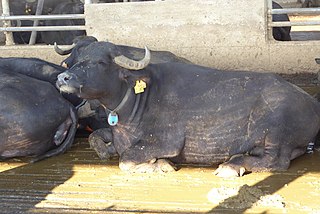
The Italian Mediterranean buffalo or bufala mediterranea italiana is an Italian breed of water buffalo. It is of the River sub-type of water buffalo and is similar to the buffalo breeds of Hungary, Romania and the Balkan countries. It is the only indigenous water buffalo breed in Italy. A herd-book was opened in 1980, and the breed was officially recognised in 2000.
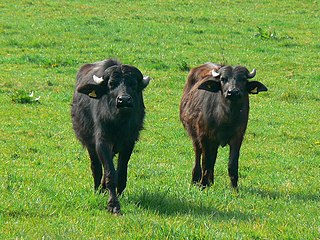
Buffalo meat, also known as buffalo beef, is the meat of the water buffalo, a large bovid, raised for its milk and meat in many countries including India, Nepal, Pakistan, Bangladesh, Philippines, Bulgaria, Italy, Russia, Czech Republic, Slovakia, Australia and Egypt.
Central Institute for Research on Buffaloes, Hisar, a publicly funded, institute for water buffalo research. It is located 170 kilometres (110 mi) from Delhi, at Hisar in the north Indian state of Haryana. It has a sub-campus, Bir Dosanjh, at Nabha. CIRB operates a nationwide network of 10 research centres working on breed improvement of the 7 main native breeds. CIRB, with over 20 laboratories for buffalo research, is the world's largest buffalo research institute with the widest range of breeds under study. With the aim of improving breeds and dissemination of information, CIRB has sold over 1,000 bulls, conducted ~200,000 artificial insemination in the field for the farmers' buffaloes with a 41% conception rate, distributed ~520,000 progeny tested frozen semen kits to 45,000 farmers and over 250 institutes, imparted training to several thousand farmers on advanced buffalo husbandry, and created the world's first online Buffalopedia in several languages. It has a large research partner network across India and the globe. It is the second institute to successfully clone a buffalo in 2016, after the first successful cloning was achieved by the National Dairy Research Institute, Karnal in 2010. In July 2017, the Indian Council of Agricultural Research ranked CIRB Hisar as India's number one Buffalo research institute for the year 2016–17.
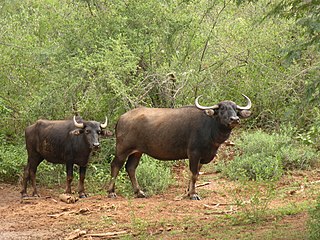
Bubalina is a subtribe of wild cattle that includes the various species of true buffalo. Species include the African buffalo, the anoas, and the wild water buffalo. Buffaloes can be found naturally in sub-Saharan Africa, South Asia and Southeast Asia, and domestic and feral populations have been introduced to Europe, the Americas, and Australia. In addition to the living species, bubalinans have an extensive fossil record where remains have been found in much of Afro-Eurasia.
Domesticated animals in the Philippines include pigs, chickens, water buffalo, goats, cats, and dogs. Domestication is when a species is selectively bred to produce certain traits that are seen as desirable. Some desirable traits include quicker growth and maturity, increased fertility, adaptability to various conditions, and living in herds. Domesticated animals play an important socioeconomic role in the Philippines, as seen through their widespread use in rituals.

Buffalypso, also called Trinidadian Buffalo, is a breed of water buffalo developed in Trinidad by veterinarian Stephen Bennett (1922–2011) in the early 1960s. The buffalypso is the result of breeding programs that crossed the swamp-type carabao with river-type buffaloes like the Murrah buffalo, the Surti buffalo, the Jaffarabadi buffalo, the Nili-Ravi, and the Bhadawari.
